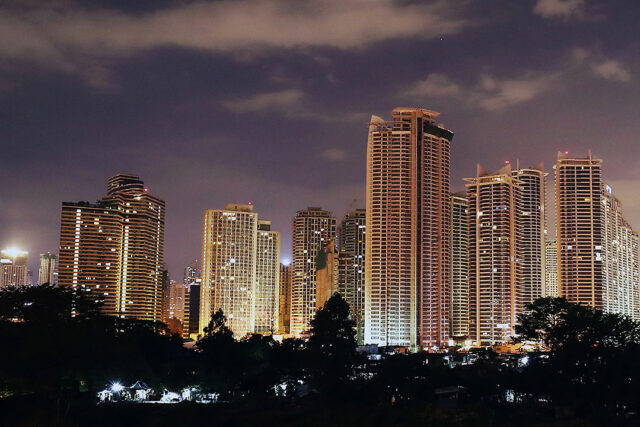By Luisa Maria Jacinta C. Jocson, Reporter
THE PHILIPPINE ECONOMY is seen to be “less affected” by the economic slowdown in China, Finance Secretary Benjamin E. Diokno said.
“The Philippines is expected to be less affected by China’s slower economic growth given that the potential slowdown in exports could be partially mitigated by the demand from our large domestic market,” he said during the ASEAN Roundtable at the World Bank-International Monetary Fund (IMF) Annual Meetings in Marrakech, Morocco on Oct. 11.
However, Mr. Diokno noted that a slowing China economy could “dampen global trade and put downward pressure on the Philippines’ goods and service exports.”
In August, total exports jumped by 4.2% year on year to $6.7 billion. The United States was the main destination of Philippine exports during the month, with export value reaching $1.1 billion, followed by Japan with $918 million. Exports to Hong Kong and China stood at $871 million and $838 million, respectively.
“Sharp swings in market sentiment and risk premia could trigger a sudden tightening of financial conditions, capital outflows, and depreciation of the peso. Intensification of geopolitical tensions and fragmentation could disrupt supply chains and investment,” he added.
Mr. Diokno said the Association of Southeast Asian Nations (ASEAN)+3 region will face both indirect and direct risks from China’s property crisis.
“We note that financial systems in the ASEAN+3 region could be exposed to risks arising from China’s property sector through three main channels: directly, through any lending to the sector; indirectly, from their exposures to other financial systems that are involved with that sector; and indirectly, from lending to their own domestic economy that may be hard hit by developments in China,” he said.
The IMF projected China to grow 5% in 2023 but slow to 4.2% in 2024, slower than previously estimated due to the property crisis and weak external demand.
‘FASTEST-GROWING ECONOMY’
While the Philippines is projected to be the fastest-growing economy in the ASEAN region this year, the outlook is still clouded by external headwinds.
“Growth in the Philippines has proven remarkably resilient over the past couple of years. After a strong rebound in 2022, the economy continues to perform well, even if it is losing momentum,” Fred Neumann, HSBC chief Asia economist and co-head of Global Research Asia, said in an e-mail.
“At the same time, the relative outperformance of the Philippine economy needs to be kept in perspective: relative to its potential, growth is currently falling short. That’s because of cyclical headwinds like higher interest rates, both locally and globally,” he added.
Multilateral lenders and institutions like the International Monetary Fund, the World Bank, the Asian Development Bank, and AMRO have downgraded their 2023 growth forecasts for the Philippines. Their estimates are below the Philippine government’s 6-7% GDP growth target but are projected to outperform economies in Southeast Asia and the Asia-Pacific regions.
“One reason why the Philippines is outperforming many peers in the region is that it is less exposed to the global manufacturing cycle: unlike other economies, which are more dependent on manufacturing exports,” Mr. Neumann said.
The Philippine economy is driven mainly by consumption. Household spending accounts for three-fourths of the economic growth.
HSBC expects Philippine GDP to average 4.8% this year and 5.2% in 2024.
“There is considerable uncertainty around these forecasts, of course, as we have little visibility yet on what third-quarter performance was. We forecast growth of 4.7% year on year for the third quarter,” Mr. Neumann said.
Pantheon Chief Emerging Asia Economist Miguel Chanco said their outlook for Philippine growth is still on the “high side” but not among the strongest in the region.
“We expect 4.5% in 2023 and 4% in 2024, which puts the Philippines more in the middle of the pack, rather than one of ASEAN’s clear regional outperformers, which was the case pre-COVID-19, alongside the likes of Vietnam,” he said in an e-mail.
“Certainly, the economy’s structural growth prospects remain solid, but there’s no denying that it’s in the middle now of a cyclical growth slowdown, which will have a bearing on its regional position.”
ING Bank N.V. Manila Senior Economist Nicholas Antonio T. Mapa said the Philippines is unlikely to post the fastest growth in the region.
“It would be good (if) the Philippines was the fastest-growing economy, however, given significant headwinds, both domestic and international will likely mean we see growth slipping to 4.8% for the year,” he said in an e-mail.
Pantheon’s Mr. Chanco also noted that the government’s 6-7% goal was “never in reach.”
“Our current forecast for third-quarter GDP growth is south of 2% year on year, which implies a technical recession in quarter-on-quarter terms. Private consumption, the economy’s main driver, is clearly wobbling, as it has fewer legs to stand on this year, versus last,” he said.
ING Bank’s Mr. Mapa said that growth may not even reach the lower end of the target for this year and 2024.
“The combination of moderating consumption due to fast-fading revenge spending and elevated borrowing costs will likely force growth to slow. We have yet to feel the brunt of Bangko Sentral ng Pilipinas (BSP) policy increases yet and we have already seen the negative impact on growth momentum,” he added.
The BSP has kept its benchmark interest rate at a near 16-year high of 6.25% since March to tame inflation.
HSBC’s Mr. Neumann noted that elevated inflation and high interest rates would weigh on household spending this year and in 2024, “though even then the Philippines will likely remain an outperformer in the region.”
To support growth, Mr. Neumann said that the country must focus on boosting foreign investments to “expand the manufacturing sector’s connectivity with regional supply chains.”
“If the Philippines can attract a greater share of regional supply chain manufacturing, boosting goods exports, growth would accelerate sustainably,” he added.
The Philippine Statistics Authority is scheduled to release third-quarter GDP data on Nov. 9.



















